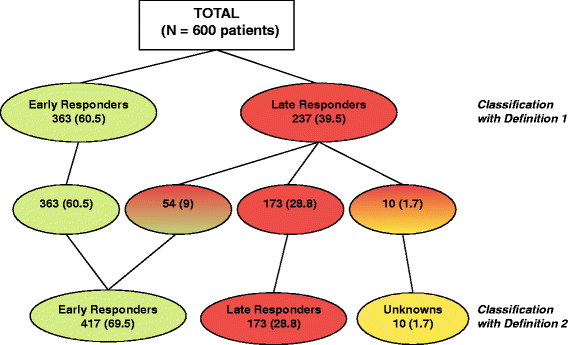Early response to antibiotic treatment in European patients hospitalized with complicated skin and soft tissue infections: analysis of the REACH study
- PMID: 25879713
- PMCID: PMC4352248
- DOI: 10.1186/s12879-015-0822-2
Early response to antibiotic treatment in European patients hospitalized with complicated skin and soft tissue infections: analysis of the REACH study
Abstract
Background: The treatment of complicated skin and soft tissue infections (cSSTI) is challenging and many patients do not receive adequate first-line therapy. REACH (REtrospective Study to Assess the Clinical Management of Patients With Moderate-to-Severe cSSTI or Community-Acquired Pneumonia in the Hospital Setting) was a retrospective observational study of cSSTI patients in real-life settings in European hospitals. In this analysis, we review characteristics and outcomes of patients with an early response (≤72 hours) compared with those without an early response to treatment. We also compare the results according to two differing definitions of early response, one of which (Definition 1) requires resolution of fever within 72 hours, in line with previous US FDA guidelines.
Methods: Patients were adults hospitalized with cSSTIs 2010-2011 and requiring treatment with intravenous antibiotics. Clinical management, clinical outcomes and healthcare resource use were assessed using a descriptive analysis approach.
Results: The analysis set included 600 patients, of which 363 showed early response with Definition 1 and 417 with Definition 2. Initial treatment modification was frequent, and highest in patients without early response (48.1% with Definition 1). Patients without early response were more likely to have diabetes than those with early response (31.6% vs. 22.9%, respectively) and to suffer from more severe disease (e.g. skin necrosis: 14.8% and 7.7%, respectively), to be infected with difficult-to-treat microorganisms and to have recurrent infections. Furthermore, patients without early response had a higher rate of adverse clinical outcomes (e.g. septic shock) and higher use of healthcare resources. The results obtained with the two definitions for early response were largely similar.
Conclusions: This study highlights the significance of early evaluation of patients in hospitals, in potentially preventing prolonged use of inappropriate or ineffective antibacterial therapy.
Trial registration: NCT01293435 .
Figures

References
-
- Dryden MS. Complicated skin and soft tissue infection. J Antimicrob Chemother. 2010;65(suppl 3):iii35–iii44. - PubMed
-
- Nathwani D, Moitra S, Dunbar J, Crosby G, Peterkin G, Davey P. Skin and soft tissue infections: development of a collaborative management plan between community and hospital care. Int J Clin Pract. 1998;52:456–460. - PubMed
Publication types
MeSH terms
Substances
Associated data
LinkOut - more resources
Full Text Sources
Other Literature Sources
Medical

